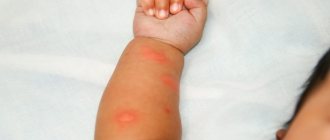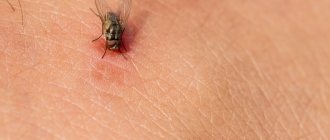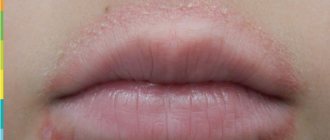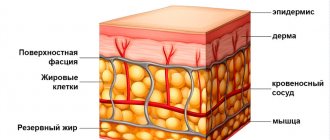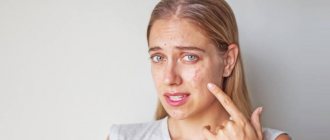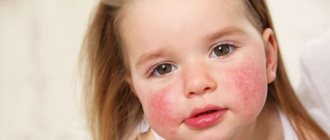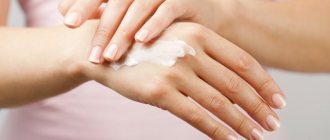Anti-cellulite, nourishing, moisturizing creams for face, hands and feet; tonics, scrubs, makeup removers and sun protection products, shampoos and conditioners - almost every modern woman has all this in her arsenal. To them you can add perfumes and all kinds of products from the group of decorative cosmetics. So it turns out that every day a modern woman, in order to look attractive, applies a huge amount of cosmetics to herself. But sometimes cosmetics can play a cruel joke and create an effect opposite to what was expected. For example, instead of masking skin imperfections or highlighting its advantages, cosmetics provoke the appearance of pimples, ulcers, inflammation, blemishes or itchy rashes. This could be an allergic reaction to cosmetics.
Why allergies occur
Allergy as an essence is an overactive reaction of the body to the effects of allergens
: substances that provoke an undesirable skin reaction. A person is a complex, individual organism, which means that the causes of allergies can be different. Most often, the tendency to certain reactions is due to a whole complex of different factors. These include:
- genetic predisposition;
- hormonal levels, the presence of chronic diseases, vitamin deficiency, decreased immunity during therapy;
- stress, climate change, neglect of protection from UV radiation;
- increased sweating and skin sensitivity.
These factors create an environment for the development of dermatitis -
skin reactions to contact with a certain irritant. In this case, both household chemicals and animals, perfumes, fabrics, flowers, medicines or food can act as an allergen.
Alas, even ordinary nuts can make you sneeze and itch, just like cleansing foam, and even your furry pet. This does not mean that you need to avoid everything around you and live in a hypoallergenic spacesuit. But it’s worth drawing conclusions and becoming more attentive to the world around you and the products you consume.
One of the possible tests for allergies is skin testing. The test is performed by an allergist
Allergies when using face cream
Allergies to face creams are quite common. A reaction can occur after using any cosmetic product, including preparations for tightening the eyelids and skin around the eyes.
Every woman regularly uses moisturizing and tightening products for her skin. Thanks to the huge range of cosmetic products, you can easily choose a face cream and hair removal cream according to your individual requirements.
However, it should be remembered that allergies manifest themselves in different forms and can develop rapidly in response to the use of eyelid creams and the skin around the eyes. Therefore, care must be taken when using them. Otherwise, allergic manifestations will have to be treated with medications.
How to recognize allergies to cosmetics
In terms of external manifestations, an allergy to cosmetics may not differ from an allergy to a new coat or perfume. However, there is a difference. Lipstick, cream or mask is applied locally, which means a reaction will occur in this area. You should be alert to symptoms such as:
- local moderate redness at the site of application;
- mild itching and burning;
- dryness, cracks and peeling;
- local tissue swelling.
These symptoms are referred to as simple contact dermatitis.
. The reaction may appear after one application and will disappear as soon as you eliminate the cause of the irritation.
Allergic dermatitis is also distinguished
. It manifests itself in the form of severe itching, rash, bright redness and weeping rashes. It can last a long time and spread to areas of the skin that have not been in contact with cosmetics.
Another type of dermatitis is photoallergic
. It is expressed in the form of rashes on open areas of the skin not protected by clothing, redness and itching. Occurs due to skin sensitivity to the sun (photosensitization) after the use of retinoids, polyunsaturated fatty acids, natural essential oils, para-aminobenzoic (PABA or vitamin B10) and salicylic acids.
Remember: only a doctor can correctly determine the type of irritation, make a diagnosis and select an effective treatment regimen!
Primary and secondary rashes
Allergic rashes on the skin of the face are divided into primary and secondary. The primary varieties include the following:
- Papule. Such rashes are called nodules. It looks like a swelling of uniform texture protruding above the skin. It has a red tint, but turns white under mechanical stress. Papules can be of different sizes.
- Pustule. It is an abscess, i.e. a cavity with purulent contents. It has a red tint with a white head in the center. When subjected to mechanical action, the pustule does not turn pale. It can be superficial and deep; in the latter case, pustules leave behind noticeable scars.
- Blister, or urtica. It has an irregular or round shape and is accompanied by itching and burning. Usually the blisters go away on their own within 24 hours, leaving no traces behind.
- Vesicle. It is a small tubercle that protrudes above the surface of the skin. It has contents of a reddish hue.
Secondary rashes include the following:
- Scab. It is a crust that appears as a result of tissue death and drying of the contents of the primary rash.
- Flake. It has a yellow or gray tint and can be of different sizes. Appears as a result of peeling and drying of the epidermis. Usually scales leave behind pustules, papules, and vesicles.
- Erosion. This defect does not affect the epidermis. Occurs after vesicles and pustules open.
Secondary rashes are a sign that the allergy is chronic, and a constant inflammatory reaction occurs in the epidermis. This means that it is imperative to identify which product you are allergic to and replace it.
Return to contents
Natural cosmetics = safe cosmetics?
Serum with a high content of vitamin C, tonic with essential oils and lemon, sea buckthorn cream. And no “chemistry”! Sounds tempting. True, this does not mean at all that an allergic reaction will not occur to these extremely “natural”, environmentally friendly products.
This may surprise you, but the most hypoallergenic products are synthetic, since they do not contain proteins that are primarily perceived by the immune system as foreign to the body and requiring immediate destruction. If you pay attention to children's cosmetics from serious large companies, the number one component there will be mineral oil. And not because “they want to destroy children” and “bathe them in oil,” but because this is the safest component that will not cause, for example, Quincke’s edema.
Causes of allergic manifestations
The main reason why a negative reaction to any creams (including depilatory creams) occurs is the composition of cosmetic products. Many of them contain secondary additives that can make the allergic reaction more severe.
The occurrence of allergies is influenced by the following factors:
Hormone levels
Hormones influence the body’s tendency to develop allergies to various cosmetics, including skin creams and depilatory creams. Hormonal imbalance increases sensitivity to allergens. Therefore, hormonal disorders should be treated promptly.
Skin type
Most often, allergies occur in women with hypersensitive skin. In addition, some women experience increased susceptibility to an allergic reaction to the cream around the eyes and eyelids, as well as the skin on the face to external climatic factors: sun, frost, wind, etc.
Metabolism
The more active the metabolic processes in the body, the lower the likelihood of developing allergies. In addition, a good metabolism activates the removal of toxic substances from the blood, which do not have time to harm the body. Metabolic processes can be affected by blood composition, as well as drug treatment. Therefore, cosmetic procedures can only be done after a complete examination of the body.
Immune system status
A good immune system allows you to fight allergens. With reduced immunity (especially in a child), all body systems become vulnerable. This condition requires drug treatment using immunomodulators.
The Traumeel line of creams, which are recommended to be applied to the affected area, has a good effect. If the body is unable to fight external and internal influences, an allergic reaction can be caused by any cream for the face, eyelids and area around the eyes. In the acute period, these symptoms must be urgently treated.
Patients who follow a strict diet are most vulnerable to developing allergies to cosmetics. This is quite simple to explain: the body suffers from a lack of vitamins and some nutrients. As a result, there is a decrease in immunity and increased susceptibility to external and internal influences.
Any of these reasons may cause an atypical reaction to the cream around the eyes and eyelids. At the same time, allergies can appear not only to new facial care products, but also to familiar ones, for example, an allergy to foundation or depilatory product.
Allergens in cosmetics according to European standards
In January 2007, the European Scientific Committee for Consumer Safety (SCCS) approved a special “List 26”. It included 26 substances that most often cause allergies in cosmetics, which, however, can be added to cosmetics, subject to mandatory inclusion on the label. Components from “List 26” are divided into two sections depending on the frequency of allergic reactions.
LIST A
“List A” includes components with a very high frequency of allergic reactions and with a large number of documented evidence.
- Amyl cinnamal is
a synthetic fragrance.
Amylcinnamyl alcohol
is a synthetic fragrance.
Benzyl alcohol
is a component of essential oils of jasmine, hyacinth, and ylang-ylang.
Benzyl salicylate
is a component of many essential oils.
Cinnamyl alcohol
is a component of cinnamon leaf essential oil, as well as Peruvian balsam and styrax.
Cinnamal
is a component of cinnamon bark essential oil.
Citral
is a component of many essential oils with a pronounced lemon sound (from lemon itself to verbena).
Coumarin
is a component of tonka bean essential oil.
Eugenol
is a component of essential oils of bay, cloves, cinnamon, basil, and nutmeg.
Geraniol
is a component of rose, palmarosa, and citronella essential oils.
Hydroxycitronellal
is a synthetic fragrance.
Hydroxymethylpentyl-cyclohexenecarboxaldehyde
is a synthetic fragrance.
Isoeugenol
is a component of ylang-ylang essential oil.
LIST B
“List B” includes components with lower frequency and less documented evidence.
- Anisyl alcohol
is a synthetic fragrance.
Benzyl benzoate is
a component of essential oils of tuberose, hyacinth, as well as Peruvian, Tolu and Copai balsams.
Benzyl cinnamate
is a component of Peruvian, Tolu and Copai balsams.
Citronellol is
a component of rose, geranium, and citronella essential oils.
Farnesol
is a component of many essential oils (from lemongrass to neroli).
Hexyl cinnamaldehyde
is a component of chamomile essential oil.
Lilial is
a synthetic fragrance.
d-Limonene is
one of the main components of citrus essential oils.
Linalool
is a component of many essential oils and is found in 200 types of plants from lavender to cinnamon.
Methyl heptine carbonate
is a synthetic fragrance.
Alpha-Isomethyl Ionone
is a synthetic fragrance.
Oak moss
- oak moss.
Tree moss
is the collective name for mosses.
Is it possible to prevent allergies?
A few rules to help you protect yourself:
- Study the ingredients of the products before purchasing.
The most common triggers for rashes and itching are natural fragrances (essential oils), some preservatives, dyes (mainly found in pigments in decorative cosmetics and hair dyes), honey and its derivatives. Rarely: mineral oils, plant extracts, minerals, lanolin. This doesn't mean you should avoid these remedies, but it's best to be on the lookout. Especially with severe skin sensitivity. - Test new cosmetics before use.
To do this, apply a little product to the crook of your elbow and wait up to 48 hours. - Follow the rules for storing products
and do not use cosmetics after the expiration date. - Always follow the manufacturer's recommendations.
Do not overexpose masks, do not apply creams to the mucous membranes, and do not use products intended for professionals without the appropriate skills.
Symptoms
To effectively combat an allergic reaction to cream, especially for depilation, it is important to know the symptoms of the disease.
The most common manifestations are:
- redness of the skin, which can spread to the neck and scalp;
- the presence of a rash in the form of pustules, papules and ordinary rashes, especially after facial masks and depilation;
- Sometimes erosive formations may occur, which require specific treatment;
- the presence of itching, which can be unbearable, even scratching. This condition causes particular discomfort for a small child. However, it should be remembered that this should not be done under any circumstances, since the risk of infection is high, which complicates the symptoms of the disease;
- over the entire surface of the body, the area under the eyes is especially sensitive; a strong burning sensation may be noted in this part of the face;
- 2-3 days after using the face and eyelid cream, peeling of the skin may appear;
- the most dangerous is edema, which can develop with varying degrees of intensity. Most often, swelling occurs around the eyes and eyelids. In more severe cases (allergy to baby cream), angioedema may develop, requiring emergency medical attention.
The primary symptoms of the disease appear a few minutes after applying the cream to the face or depilation area. First of all, a burning sensation is noted, then hyperemia of the skin around the eyes and eyelids appears. Then rashes and swelling are noted.
If these symptoms increase, an urgent visit to a doctor is required, who will select the necessary treatment. In the case where symptoms are observed in a child, treatment is recommended under the supervision of a pediatrician.
If an allergy is identified, a number of therapeutic measures and cessation of contact with the provoking substance are required.
Treatment depends on the strength of allergic symptoms, for which the following prescriptions are recommended:
- It should be borne in mind that fighting the disease (especially in a child) requires identifying the allergen. This must be done as quickly as possible, using an allergy test. During a diagnostic examination, this should be done without fail;
- as a rule, treatment is prescribed with antihistamines for internal use (Zodak, Claritin, Zyrtec, etc.);
- in severe cases, treatment with external agents (Kremgen, Traumeel, Hydrocortisone) can be used. Cream Traumeel has a positive effect. It has a drying effect, relieves inflammatory processes;
- Traumeel cream allows you to effectively treat acne. It must be applied in a thin enough layer so as not to dry out the skin, since Traumeel cream contains a small amount of ethyl. It is also a herbal preparation, so you can do procedures with it without restrictions. Traumeel is absolutely safe, you can smear it on the delicate skin of a child;
- It is also permitted to use the Clean Line series of cosmetic preparations in a closed tube with a dispenser, since the interaction of the Clean Line cream, as well as Traumeel cream with oxygen, disrupts their properties. This can affect the skin, especially in children.
As a rule, there are practically no side effects with Traumeel, and those that do appear are associated with individual intolerance to the components. In addition, treatment (especially for a child) requires compliance with the shelf life of the drug.
What to do if your skin reacts to cosmetics
If any component of cosmetics does cause an undesirable skin reaction in you, then the first thing to do is stop using this product and wash it off your skin
. After this, you should check the instructions and check the expiration dates. If you did everything correctly and the cosmetics are not expired, act according to the situation:
- Watch the dynamics. If the reaction begins to subside within an hour, it is enough not to use the product anymore.
- Take your usual antihistamine (Suprastin, Fenistil, etc.)
- If symptoms persist, consult your doctor
.
What to do next?
The first desire after purchasing unsuitable cosmetics is to return it to the store and receive compensation from the manufacturer. However, according to the consumer protection law, cosmetics are included in the list of products that cannot be returned or exchanged
(see Decree of the Government of the Russian Federation dated January 19, 1998 No. 55
“On approval of the Rules for the sale of certain types of goods...”
). You can get your money back only in one case: if the cosmetics you bought turned out to be of poor quality. Keep in mind: an individual allergic reaction does not prove that the product is defective.
Therefore, it is better to offer the remedy to someone else, explaining the situation honestly. Place ads on special services, in thematic groups on social networks, or share an unsuitable product with family or friends.
As for further purchases, do not rush to give up shopping! If a rash occurs with one cream, this does not mean that the same reaction will occur with another. Try to establish which component triggered the allergy.
. An allergist can help with this by prescribing the necessary tests. In the future, just avoid products containing this ingredient.
Why does an allergic reaction occur to the cream?
The cause of an allergic reaction may be a hereditary factor.
Too frequent use of cosmetics can also be a cause.
The skin gets used to the frequent application of moisturizing and toning creams, which is why various irritations and swelling appear.
But most often, the occurrence of allergies is facilitated by various components that make up the cream:
- Firstly, these are dyes. They are added to ensure that the color of the cream is snow-white.
- Secondly, fragrances. Obviously, a pleasant-smelling cream is pleasant to use. But don’t forget: the more pleasant the cream smells, the more fragrance components it contains. It is believed that fragrances made from natural components are practically harmless, unlike chemical ones. But plant extracts containing essential oils are strong irritants. Accordingly, the more aromatic the cream, the more reasons for allergies.
- And thirdly, preservatives. Many creams have quite long expiration dates. And all this thanks to those same preservatives, which contain chemical compounds hazardous to health. And even such natural preservatives as wax and honey will not protect you from rashes, especially if you have an allergic reaction to sweets.
How we take care of our clients
pays close attention to cosmetic ingredients. We use components from trusted laboratories that have the necessary safety and quality certificates. Before release, our products are tested in laboratories. For your convenience, we place detailed information about the composition and features of the use of our products on the packaging and in product cards in the official online store aravia.ru.
In case of an undesirable skin reaction to the product, we ask you to send us an email
- photos of skin reactions;
- photographs of the product so that the batch number is visible;
- a detailed story about exactly how you used the product;
- additional contacts for prompt communication.
We will then be able to help you and determine the possible cause of the reaction, and decide as quickly as possible how to proceed.


